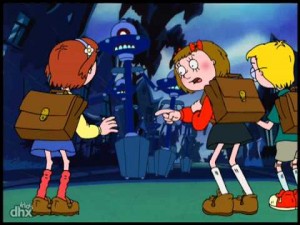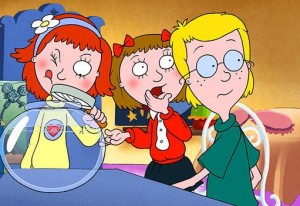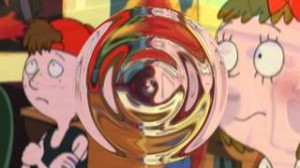Written by Elizabeth Kiy as part of our theme week on Children’s Television.
As a kid, I had a boundless imagination.
I put on plays in my backyard (notably a bowdlerized Romeo and Juliet) and my friends and I spent our recesses pretending we were princesses, fairies, cowgirls, mermaids and Hogwarts students. I convinced my little sister we were always traveling the world- any clock tower was Big Ben, a local bridge was the Golden Gate and power line towers were always the Eiffel Tower.
In short, I was a lot like Mona the Vampire. Or at least, I see a lot of myself in her.

I’m unsure if the show is at all familiar outside Canada. Here, it ran for four seasons (1999-2003) on YTV (basically our equivalent to Nickelodeon) and I binge-watched it on weekends and as treat whenever I stayed home from school sick.
The series chronicled the adventures of Mona Parker, a young girl who enjoys dressing up like a vampire and sees saving her town from monsters as her mission in life. The stories are Buffy-lite: a giant bug substitute teacher, a robot babysitter, doppelgängers, a computer virus with mind-control powers, and new cafeteria cooks who aim to poison the school with salmonella.
Though the show often pulls out of Mona’s fantasies to reveal the reality of the situation, Mona’s fights against the forces of darkness, usually end up somehow solving the crime or prank, exposing a conspiracy or locating the lost item anyway.
And Mona is never deterred by rationality, in her mind, everything out of the ordinary has a supernatural explanation and nothing can convince her otherwise.

As a lead character on a children’s show, Mona is refreshingly atypical. When deciding on alter ego, she eschews the traditional superhero or princess dress and chooses to be a vampire. As a female character, Mona is also unique in her love of scary stories and late night horror movies, comic books and gruesome creepy crawlies. With her usual costume, which she chose herself and slips on at every opportunity, she tries to make herself as frightening as possible with a wig of wild, gravity-defying braids, plastic fangs and exaggerated purple circles drawn under her eyes.
However, the general effect is more adorable than intimidating and with her high pitched voice, it’s clear she’s still a child, unsure of her place in the world, underneath it all.
In fact, like Batman, she considers her true self to be her caped crusaded identity. Mona Parker, not Mona the Vampire, is the disguise. Though Mona sees herself as a vampire, she never troubled with questions of morality, in her view, she’s a good vampire and that’s that. She doesn’t need to bite people or drink blood, but instead has vampire senses that tell her when trouble is near.

Unlike the brooding vamps we’re used to, Mona also has a child’s sense of morality. She believes that she and her friends are good while the monsters they fight are all bad. For example, Von Kreepsula is Mona’s nemesis, an evil vampire to match her good.
But like the children watching the program, Mona learns that morality is not so black and white
In several episodes, Mona learns the monster she’s been fighting is merely misunderstood, lost it’s home or separated from it’s family. Even her sense of self is challenged when Mona meets a vampire hunter and has to convince her of her essential goodness.
Though Mona is neither binary extreme of masculinity or femininity, the two options usually available to children’s heroes and heroines, her friends and sidekicks Charley (AKA Zappman) and Lily (AKA Princess Giant) certainly are.

Like Mona, Charley and Lily are imaginative kids who love to play her games, though it’s a little unclear to what extent they believe in actually believe in the monsters and vampires infesting their town. While both are timid and scared on their own, Mona’s bravery and self-confidence buoys them are draws them into her world.
What I found so refreshing was Mona’s personality as a leader, the Really Rosie type, the Queen of the neighborhood. As a leader, Mona also helps her less confident friends discover their skills and strengths by making them vital parts of her fantasy narrative. She can only defeat the monsters with the help for Charley’s Zapp-A-Rama Gun, his aptitude for science and Lily’s ability to grow.
She introduces them to the highly covetable idea of developing a superpower that makes your weaknesses into strength. Sure Charley is easily scared and often bullied, but with Mona’s encouragement to be the superhero she sees in him and encourages him to see for himself, he’s just like his hero, the Man with Nine Lives. Likewise, without Mona, shy Lily hides behind her hair and lets others push her around and feel her small. When they meet, Mona tells Lily she can have any type of alter ego she wants and chose her own powers. Lily chose to become the braver version of herself that she hopes to grow into, and takes on the power to make herself as big as she wants, so no one can intimidate her and make her feel unimportant.

Closing out the pack is Mona’s trusty cat and confidant Fang is always there as back-up and a (silent) voice of reason anyway. Fang may have more sense than either kids or adults and his expressions often silently suggests the problems in Mona’s logic that no one else can see.
Mona’s parents are supportive but weary. They believe they are raising a highly intelligent, imaginative child, one who gets in her fair share of trouble but is loyal to her friends and always able to find a way out of a jam. They’re the kind of parents every wildly imaginative kid should have, people who always know there are many reasons to be proud of their daughter and nurture her creativity.
Moreover, Mona’s friends are also posed as underdogs throughout the series. Mona’s nemesis is Angela, the cruel and vain daughter of lottery winners who believes she can win friends by showing off her enormous wealth. George, often Angela’s henchmen, is a crude bully who mainly picks on Charley, but is the Principal’s nephew, so he rarely gets in trouble. In comparison, each episode, Mona shows she can save the day with just her wits and imagination, teaching young viewers their value above all.
As with many children’s shows, the kids on Mona the Vampire are smart and resourceful, solving crimes even the police can’t and speaking and working with adults like colleagues, the ultimate fantasy for most real-life kids. In many episodes, Mona deals with the local chief of police, Officer Halcroft who offers rational explanations to each incident. Each time, she dismisses them as ridiculous and unbelievable.
I also love how improvised the character’s costumes seem, like real things the kids could have gathered from around the house. Mona’s floral cape is an old curtain, while Princess Giant’s long blonde hair is a mop. This small aspect of the series adds realism to their imaginings and suggests that the show’s creators consider or remember the actual mechanics of children’s fantasy games.

In addition, the show refuses to underestimate children as an audience, the stories are never definitively attributed to natural or supernatural causes and the show never overtly indulges or refutes her world. The transition effect between “reality” and Mona’s fantasy gives viewers room to judge how much of the fantasy is real. Many episodes even end on an uncertain note, with even the adults unable to explain every detail rationally, suggesting there may be some truth to Mona’s imagination.
Mostly I liked the show because it clearly respected and celebrated the dreamworld so essential to childhood and creative, curious children. With imagination like Mona’s, even the ordinary world can be magical.
Elizabeth Kiy is a Canadian writer and freelance journalist living in Toronto, Ontario.

Show us your fangs… YAY MONA!!
They aired this show on kids’ TV in the UK, and I enjoyed it quite a bit. My favorite part was the way Mona would always preface her supernatural suggestions with “There’s only one explanation…” — that got quoted a lot among my friends, before proposing something totally outlandish.
Thanks for writing this, Elizabeth!